Not many people know the name of Japanese architect Matsunosuke Moriyama, but they have all seen his works — whether it is the Presidential Office, the Taipei Guest House, the Control Yuan building or the headquarters of Taiwan Tobacco and Liquor Corp.
The Presidential Office and the Taipei Guest House are the two projects that best represent Moriyama’s works, said the researchers of the book Foreigner in Formosa (異人的足跡), published by the Academia Historica, who revisited the works and life of Moriyama and credited him “the helmsman who shaped the style of public buildings in Taipei.”
The Presidential Office was originally the Taiwan Governor General’s Office during the Japanese colonial era, while the Taipei Guest House was the governor general’s residence.
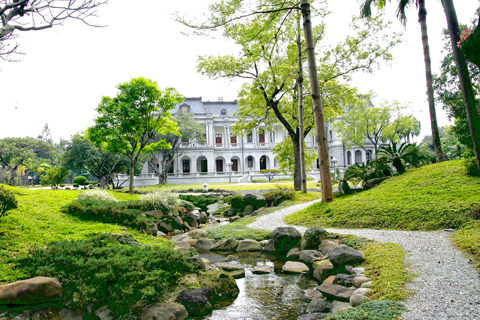
PHOTO: COURTESY OF ACADEMIA HISTORICA
Huang Chun-ming (黃俊銘), architecture professor at Chung Yuan Christian University, said the location of the Governor General’s Office was determined in 1900, when the Japanese colonial government laid out its first urban planning design for Taipei.
“In the plan, the office faced directly at the Jingfumen (景福門), the East Town Gate built in the Qing Dynasty,” Huang said. “In between the gate and the Governor General’s Office was a large avenue, which is now Ketagalan Boulevard. You can see all the way from Jingfumen to the entrance hall [of the Presidential Office].”
The construction of the Governor General’s Office began in 1912 and it was completed in 1919. For the project, the colonial government held a competition to solicit draft plans from architects. The one pitched by Moriyama was not selected. Instead, the colonial government chose one submitted by Uheijui Nagano, another Japanese architect.
Moriyama later became construction division director at the Governor General’s Office site. He modified Nagano’s original design by adding a 60m-tall tower on the top of the office building, which was viewed by many as an important symbol of Japanese rule.
Huang said Moriyama preferred baroque architecture, which explained the magnificent decorations in the entrance hall.
The Governor General’s Office was later bombed by the US Air Force during World War II. The pillars in the entrance hall were destroyed in the air raid. Nevertheless, one can still see the pedestals of the double-column pillars in the entrance hall today.
The West Wing of the Presidential Office, on the other hand, is the only part of the building that was not damaged during the war.
As smoking was prohibited in most of the Governor General’s Office, Huang said smoking lounges were built on the four corners of the building, adding that they also helped turn the building into a structure that could withstand earthquakes.
Hsueh Chin (薛琴), another professor of architecture at Chung Yuan Christian University, traced the history of the Taipei Guest House and found a rather controversial past during the colonial era.
“The proposal for building the governor general’s residence generated quite a debate at the Imperial Diet in Japan,” Hsueh said. “Back then, Taiwan still needed to be subsidized by Japan, but Taiwan’s governor general wanted to live in a house that was more grandiose than the Imperial Palace of Japan. This sounded ridiculous to members of parliament.”
Shinpei Goto, then head of the civilian affairs bureau, defended the construction, saying: “How can royalty gain the respect of the people if people do not know the kind of places royalty lives?”
Hsueh said Goto’s argument helped him secure approval for the project from the Imperial Diet.
The construction of the governor general’s residence was completed in 1901. Because of the humidity in Taiwan, the wooden structure was soon eroded by termites.
So in 1911, Moriyama was put in charge of a renovation project and he replaced the wooden framework with steel to solve the termite problem. He also expanded the size of the residence and landscaped its gardens.
The renovated residence was also equipped with a Mansard roof — a four-sided roof with a double slope on each side.
Meanwhile, single columns on the balcony of the second floor were turned into pairs of columns, with goat horns or other Greek style ornaments above them.
The chandeliers and wall decorations inside the residence were all gilded, Hsueh said.
The residence was mainly used to house the Japanese royal family when they visited Taiwan, Hsueh said, adding that the governor general himself, in fact, lived in a Japanese-style house built right next to the residence.
“Though the Japanese people tried hard to be westernized after the Meiji Restoration, they still preferred their own culture, so you will see the combination of Western and Japanese architecture in Japan a lot,” Hsueh said.
A graduate of the architecture department at Tokyo Imperial University, Moriyama was one of many architects who traveled to Taiwan in 1907. Though born into a political family, he chose to dedicate his life to architecture instead. His professor was Kingo Tatsuno, who learned from British architect Josiah Conder.
Conder was invited to teach at Tokyo Imperial University and educated Japanese architects on Western-style buildings during the Meiji Restoration.
As director of the construction division of the Governor General’s Office, Moriyama designed and supervised the execution of the public building projects in Taiwan. Aside from the Presidential Office and the Taipei Guest House, Moriyama was also in charge of constructing the city government offices in Taichung and Tainan.
Chinese Culture University professor Lee Chien-lang (李乾朗) said Moriyama came to Taiwan during the Taisho era in Japan. Japanese architects had traveled to Taiwan both before and after Moriyama arrived, he said.
“Unlike his peers, however, Moriyama preferred the baroque architectural style, but he also tried to incorporate his personal style into his works,” Lee said.
Lee said South Korea debated a decade ago whether it should keep its Japanese General Government Building. The South Korean government eventually decided to tear it down because it was a symbol of the Japanese colonial era.
“The General Government Building was built right in the front of the Imperial Palace in South Korea and this was seen as a deliberate humiliation, a slap in the face of Koreans,” he said.
To build the Governor General’s Office in Taipei, the Japanese had to relocate the ancestral temples of the Lin (林) and Chen (陳) families, the two largest clans in Taiwan, Lee said.
That, however, was not deemed a humiliation because both families received compensation for the relocations, Lee said.
Moriyama returned to Japan in 1921 and continued to engage in architectural design in the private sector. When he designed the Imperial Pavilion at Shinjuku Gyoen National Garden in Japan, he also applied Taiwanese architectural style and built it with red cypress and bricks imported from Taiwan. The Imperial Pavilion is also known as the Taiwan Pavilion.
Lee said Moriyama helped enlighten the public by constructing these European-style buildings because at the time a lot of Taiwanese did not have much exposure to Western culture.
“They [the buildings] also brought diversity to the Taipei City’s landscape,” he said.
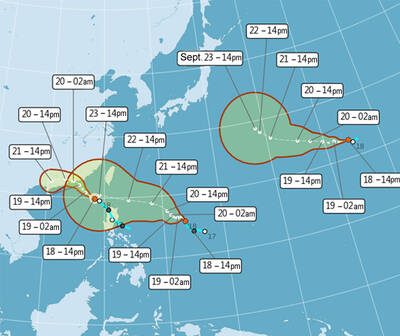
PEAK MONTHS: Data showed that on average 25 to 27 typhoons formed in the Pacific and South China seas annually, with about four forming per month in July and October One of three tropical depressions in the Pacific strengthened into a typhoon yesterday afternoon, while two others are expected to become typhoons by today, Central Weather Administration (CWA) forecaster Lee Ming-hsiang (李名翔) said yesterday. The outer circulation of Tropical Depression No. 20, now Typhoon Mitag, has brought light rain to Hualien, Taitung and areas in the south, Lee said, adding that as of 2pm yesterday, Mitag was moving west-northwest at 16kph, but is not expected to directly affect Taiwan. It was possible that Tropical Depression No. 21 would become a typhoon as soon as last night, he said. It was moving in a
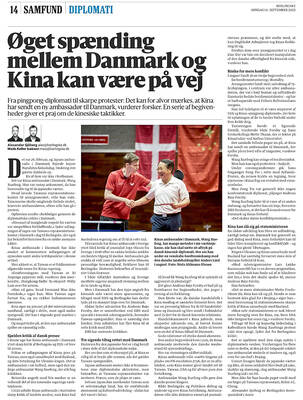
A Taiwanese academic yesterday said that Chinese Ambassador to Denmark Wang Xuefeng (王雪峰) disrespected Denmark and Japan when he earlier this year allegedly asked Japan’s embassy to make Taiwan’s representatives leave an event in Copenhagen. The Danish-language Berlingske on Sunday reported the incident in an article with the headline “The emperor’s birthday ended in drama in Copenhagen: More conflict may be on the way between Denmark and China.” It said that on Feb. 26, the Japanese embassy in Denmark held an event for Japanese Emperor Naruhito’s birthday, with about 200 guests in attendance, including representatives from Taiwan. After addressing the Japanese hosts, Wang
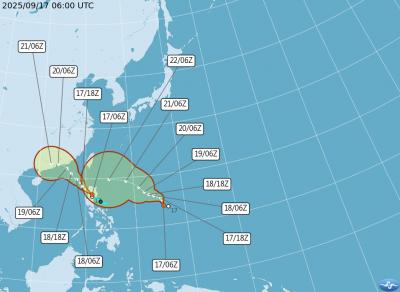
One of two tropical depressions that formed offshore this morning could turn into a moderate typhoon by the weekend, the Central Weather Administration (CWA) said today. Tropical Depression No. 21 formed at 8am about 1,850km off the southeast coast, CWA forecaster Lee Meng-hsuan (李孟軒) said. It is expected to move in a northwesterly direction as it continues building momentum, possibly intensifying into Typhoon Mitag this weekend, she added. The radius of the storm is expected to reach almost 200km, she said. It is expected to approach southeast of Taiwan on Monday and pass through the Bashi Channel between Tuesday and Wednesday,
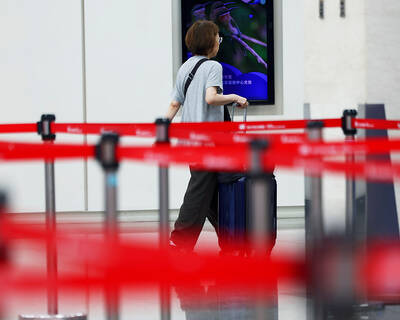
About nine Taiwanese are “disappeared,” detained, or otherwise deprived of freedom of movement in China each month, the Mainland Affairs Council (MAC) said yesterday. Between Jan. 1 last year and Aug. 31 this year, 188 Taiwanese travelers went missing, were detained and interrogated, or had their personal freedom restricted, with some questioned in airports or hotel lobbies, the council said. In a statement ahead of the Mid-Autumn Festival, the council urged people visiting China for any reason to be highly vigilant and aware of the risks. Of the reported cases, 50 people were “disappeared” after entering China, 19 were detained and 119 had